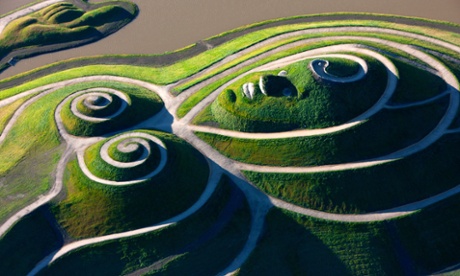
Northumberland is a wild and beautiful place. Tourists visit for the history, for the hills and the wide, empty beaches. They drive west to Hexham and Hadrian’s Wall or north to Alnwick and Holy Island, but they usually ignore the coastal plain in the south east corner of the county where once coal was mined and ships built.
If you take the Spine Road – the A189 from Newcastle – and look out over the flat farmland towards the sea, the view is almost entirely industrial. You see the chimneys of the power station that used to provide energy for the Alcan smelter, a giant offshore wind farm and the cranes at Blyth Docks. But nature is taking over again, now the heavy industry has retreated. The subsidence pools and the recently planted reed beds just inland from the dunes at Druridge Bay are wild and beautiful, with a rich variety of wildlife. The coastal towns have an authenticity lacking in the tourist-focused villages.
The mining tradition is celebrated at the Woodhorn Museum, where coal was mined for 80 years. This is an important story, as much a part of Northumberland’s history as the Roman Wall, and it’s impossible to understand north east England, its passions and resentments, without knowing something of the industry that powered the nation.
More land reclaimed from old deep mining, and more recent open cast or surface mining, which continues, have been turned into sites managed for plants, birds and animals, and most are administered by the Northumberland Wildlife Trust. The quirkiest of these is Northumberlandia, a huge soil sculpture of a supine woman. The site is entered through mature woodland, then paths lead across grass and beside pools to various parts of her body. Only after a steep climb to the top of the head can the entire sculpture be seen, and suddenly the mining work beyond becomes visible in all its drama.
The QEII Country Park is made up of woodland with a lake that attracts waterfowl, red squirrels and families, and looks like grounds that might once have surrounded a stately home. The park was formed after years of reclamation and a massive earth moving project that shifted one of the biggest spoil heaps in Europe. Other Wildlife Trust reserves are more settled and seem a part of the farmland. Cresswell Pond is a large, brackish pool originally created as the result of collapsed mine workings. It’s so close to the wide sweep of Druridge Bay that salt water seeps into it, forming a unique habitat. Birders go for avocets, terns, egrets. Otters are regularly seen from the hide too. I go for the fantastic homebakes at the Drift Cafe nearby.
Druridge Pools, in a tangled wilderness of bushes and wild flowers, separated from the beach by dunes, supports large flocks of wildfowl and attracts waders. East Chevington is also good for birdwatching.
I can only sit in a hide for so long. Often our last stop is Amble, a small working town with a harbour at the mouth of the River Coquet where eider ducks live and there are boat trips. Amble isn’t wealthy, but recently it’s attracted fine cafes and restaurants and tourists who stay in holiday cottages in the more fashionable Alnmouth and Alnwick stray south to taste Spurreli’s ice cream or the very good fish at the Old Boathouse. If those visitors immediately head north again, they’re missing out. Everyone should enjoy Northumberland’s spectacular scenery and wide open spaces, but discover its more modest pleasures too.
The Moth Catcher by Ann Cleeves is published by Macmillan on 10 September, hardback £16.99. To order a copy for £13.59 go to bookshop.theguardian.com
MORE QUIET SPOTS AROUND THE UK…
Nidderdale
Bordering the Yorkshire Dales national park, Nidderdale Area of Outstanding Natural Beauty offers a mix of heather moorland, rolling hills and pretty villages. How Stean Gorge is a 1km-long, 20m deep limestone chasm that can be explored on foot, or by caving or via ferrata. Or walk a llama at Nidderdale Llamas. In Masham, Suncatchers Cafe is cool and quirky.
Eden Valley
Between the Pennines and the Lakes, Eden Valley has far fewer visitors and glorious hills for rambling. Walkingworld.com has 20 suggested walks, from 2-11 miles long. A pint in The Old Crown in Hesket Newmarket is a must – it’s Britain’s first co-op pub, co-owned by 150 people. Askham Hall overlooks the river Lowther and has fine dining and a cosy cafe. On a rainy day, there’s the Eden Valley Railway, Warcop, or Appleby Castle.
Heddon Valley, Exmoor, Devon
Walk Heddon Valley on the South West Coast Path along dramatic cliffs in this hidden corner of Exmoor national park. When walking back from Woody Bay towards Heddon Mouth, instead of taking the high path walkers should take the one along the cliff – brilliant with heather and wild flowers in August. Hunter’s Inn on Exmoor is the place to refuel.
Dulwich Woods, London
When walking through Dulwich Woods and adjoining Sydenham Hill Woods, the rest of the capital seems a world away. Peaceful, shady and presently full of wild blackberries, the trail leads to the newly revamped Dulwich Woodhouse pub, with seating in garden huts, a burger shack and roasts. On 29 August there’s a garden party with gypsy jazz and a dog show.
• This article was amended on 2 September 2015. An earlier version referred to Northumberlandia as a sculpture of a prone, rather than supine, woman.

